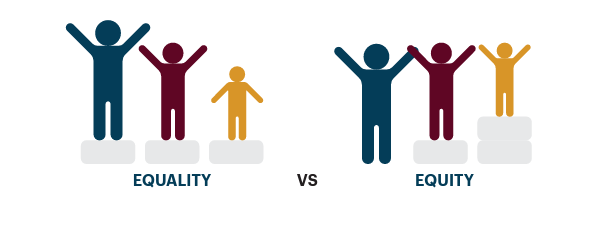
In the workplace, when diversity, equity and inclusion (DEI) work in tandem and are centered in both an organization’s values and in practice, a sense of belonging is fostered. When we feel psychologically safe and that we belong, we are more likely to show up as our full authentic selves without fear of negative consequences to opportunities, reputation or work relationships. Some companies use the terms equity and equality interchangeably, but they differ. Having the knowledge, awareness and language about these difference and how they relate to workplace culture can help you identify organizations with an equity-focus, know what to look for in your search, articulate your questions to assess an organizations’ DEI priorities and commitment in your interviews, and advocate for what you need to thrive in your career. Here’s how the two concepts differ in a workplace context:
Equality involves treating all employees or individuals in the same manner, regardless of their backgrounds, identities, or circumstances. It aims to ensure that everyone is subject to the same rules, policies, and opportunities. While this approach may seem fair on the surface, it doesn’t take into account that different employees may have different needs or face unique barriers. For example, providing the same resources or support to all employees might not adequately address the challenges faced by those from historically marginalized groups.
Equity is giving everyone what they need to be successful. “Whereas equality means providing the same to all, equity means recognizing that we do not all start from the same place and must acknowledge and make adjustments to imbalances. The process is ongoing, requiring us to identify and overcome intentional and unintentional barriers arising from bias or systemic structures” (National Association of Colleges and Employers, 2023). Equity initiatives aim to create an environment where all employees have the opportunity to thrive by tailoring resources, opportunities, and support to meet their specific needs. This might involve implementing mentorship programs, flexible work arrangements, or other measures to ensure that individuals from marginalized groups have an equal chance of success.
Imagine a tall fence where everyone is given the same size box to stand on. However, some people might still not be able to see over the fence due to differences in their height or other factors. If we apply equity in this case, individuals are given boxes of varying sizes based on their individual needs. Shorter individuals might receive taller boxes, ensuring that everyone has an equal opportunity to see over the fence.
As you embark on your job search and your career development journey, ask yourself not only where do you see yourself in 5 years, but more importantly, how do you want to feel at this job in 5 years? What values and practices would you like to see reflected in your place of employment? “Conscious job seeking is searching for employment or contractor opportunities that align with your vision, mission, values, and goals,” explains Chelsea C. Williams, founder and CEO of College Code.
Here are some potential strategies you can take to help you identify and find an equity-minded workplace:
- Research the values and mission of potential employers.
- Review the company’s diversity and inclusion initiatives. This might include mentorship programs, employee resource groups, training programs, diversity recruitment initiatives, etc.
- Look for employee reviews and testimonials about the company culture on websites like Glassdoor.
- Assess the diversity of the company’s leadership team and workforce.
- Review the company’s policies, benefits, and practices. Look for policies that address pay equity, flexible work arrangements, parental leave, and accommodations for employees with diverse needs.
- Ask questions during interviews that can help you gauge the company’s commitment to equity.
- Reach out to current or former employees to learn more about their experiences with equity and inclusion at the company.
- Pay close attention to the company’s culture and environment during your interview process or company visits.
- Look into the company’s involvement in community initiatives, partnerships, or programs related to diversity and equity.
- Trust your instincts. If you have reservations about a company’s commitment to equity, it might not be the right fit for you. Look for a workplace where you feel valued, respected, and confident that your unique experiences and contributions will be appreciated.
The workplace context requires a nuanced understanding of both equity and equality. Striving for equity involves recognizing and rectifying historical and systemic imbalances to ensure that all employees have an equal opportunity to succeed. Conscious job seeking is a tool that can help guide you in your search for an organization that aligns with your values and for an environment and culture where diversity, equity, inclusion, access and belonging matter.
